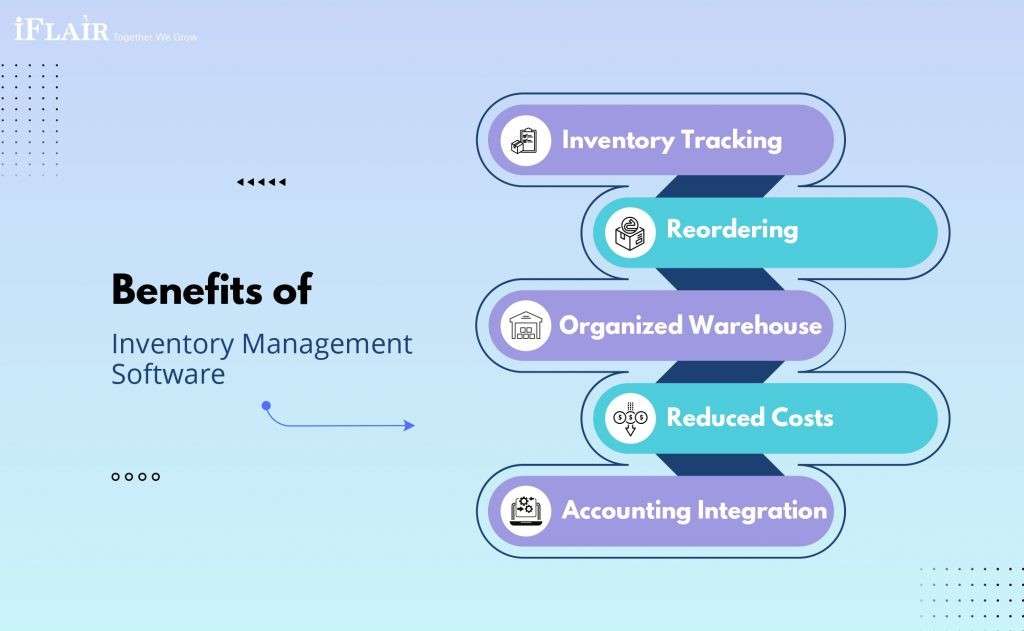
A Beginners’ Guide to Understanding the Inventory Management Software
May 17, 2023 |
11 minutes read

Businesses must put proper inventory management in place to effectively manage their stock of products or raw materials. Inventory management used to be done manually, which was time-consuming and error-prone. However, since the development of contemporary technology, businesses may now automate the procedure using inventory management software. This not only lowers errors but also helps warehouse managers track and maintain their product inventory more efficiently.
What is Inventory Management?
Inventory management involves monitoring, documenting, regulating, and arranging the goods. It assists companies in accurately documenting purchased items and sold products and keeping track of current inventory levels. Efficient inventory management can help businesses operate more effectively, save money, and meet customer demands. By using Inventory Management Integration Services, businesses can monitor their entire inventory effortlessly and guarantee that the correct products are always available.
What are the different types of Inventory?
To effectively manage your inventory, it’s important to know the four most commonly used types: Raw Materials, Work-In-Process (WIP), Finished Goods, Maintenance, Repair, and Overhaul (MRO). Use this knowledge to choose the best inventory management software and improve control over your inventory.
- Raw materials: Raw materials are the items in your inventory used to create finished products. These materials consist of parts currently in stock but have not yet been used to make work-in-process or finished goods inventory.
- Work-in-Process (WIP): Work-in-process inventory refers to the items currently in production and is not yet at the finished goods stage. This type of inventory usually has a longer lead time for manufacturing and often includes several stages between raw materials and finished goods inventories.
- Raw materials: Raw materials are the items in your inventory used to create finished products. These materials consist of parts currently in stock but have not yet been used to make work-in-process or finished goods inventory.
- Finished Goods:Products that are finished and ready for sale to clients are referred to as finished goods. Typically, this kind of inventory has a quicker manufacturing lead time and is prepared for dispatch practically immediately after production.
- Maintenance, Repair, and Overhaul (MRO):Maintenance, repair, and overhaul (MRO) inventory is made up of parts that are used to keep equipment running and fix it when it breaks.
How does Inventory Management Software work?
Businesses can use inventory management software to keep track of their orders, sales, and other relevant information. By automating inventory-related duties such as tracking and administration, the software enables warehouse to improve their inventory control procedures and lower errors.
With inventory management software, businesses can set a reorder point, that alert the manager when the level drops below a determined level. This reduces the possibility of stockouts and overstocking while ensuring that businesses always have the supplies they require on hand.
The software can track inventory levels as well as sales patterns and consumer behavior, which is useful information. As a result, warehouse may be better equipped to decide which products to stock and when to place new orders as part of their inventory management plans.
Benefits of Inventory Management Software

Using inventory management solution can help you manage your inventory more efficiently. This tool can track all of your arriving and outgoing goods whether you’re a factory, retailer, or warehouse management. Utilizing inventory management software has a number of advantages:
- Inventory tracking: Inventory management software helps you keep track of your inventory in real time and see its movement across your ecosystem by connecting it to other critical systems so you can do both of these things more easily. When this is done, the risks of human error that are associated with manual spreadsheet systems are significantly reduced.
- Reordering: Effective inventory management software maintains a comprehensive record of your entire inventory and simplifies the reordering process to prevent the shortage of essential items. It can also be customized to assist you in buying sufficient items to fulfill orders without accumulating excess inventory that might expire or remain unused on your shelves for an extended period.
- Organized warehouse: Inventory management software facilitates warehouse organization by tracking the location of each item, thereby improving operational efficiency. Avoiding possible misplacements or theft of goods due to poor organization also reduces time spent searching for items.
- Reduced costs: Using inventory software can avoid common expenses such as overstocking, which requires more storage space and leads to unnecessary costs.
- Accounting integration:Systems for inventory management can be combined with the best accounting software. This integration helps prevent data duplication and gets rid of any potential for misinterpretation and human error.
Features of Inventory Management Software
Inventory Control Management Software should possess the following features to help businesses improve their processes:
Stock Management
You can keep track of the location and quantity of items with the help of the stock management tool. Every time fresh product is received or sent from your warehouse, the system updates your stock levels. You can view the most recent data regarding the quantity of items in your warehouse and their present locations with this tool.
Procurement Management
The procurement management feature permits you to set a specific level of remaining stock for each item, called the reorder point. It also enables you to generate purchase orders whenever the product reaches that level, so you can restock and avoid running out of inventory. With this feature, you can automate ordering and prevent stock-out situations.
Supplier Management
Using this option, you can save details about your suppliers, including their costs. By using this data, you may evaluate the costs and forecasts of many suppliers and select the one who provides the best deal for the good you wish to purchase.
Shipment Tracking
You can trace the whereabouts of packages you’ve shipped to customers using the shipment tracking feature. This function is especially well-liked by e-commerce companies who sell the majority of their products via shipping. Monitoring each package’s actual location and informing your customers of it improves accountability, fosters good communication, and lowers the possibility of orders going missing or becoming misplaced.
Inventory Reports
This function offers thorough reports on your inventory, sales, and operations that can help you make important choices. Reports on inventory typically include statistics on trends in sales and purchases, inventory specifics, activities, and other information.
Barcode Scanning
You can quickly and precisely trace everything that is coming into and going out of your warehouse using the barcode scanning feature. Time is saved, accuracy and efficiency are increased, and mistakes caused by manual data entry are eliminated.
Alerts & Notifications
Inventory management software also comes with alerts and notifications features. These features provide timely warnings when stock levels fall below the reorder point or when an order is past due, allowing you to take corrective action before any issues arise.
Integration with Other Systems
Other business systems, such as accounting software, CRM systems, enterprise resource planning (ERP) tools, product information management (PIM) solutions, or e-commerce platforms, can be integrated with inventory software. This helps to ensure that all relevant information is passed along seamlessly and reduces the possibility of manual errors.
Boost Efficiency and Streamline Operations with Our Inventory Management Software!
Conclusion
The businesses simply cannot ignore the contribution of inventory management software to track their inventory, streamline processes and boosting up their online and offline productivity. A good inventory management system cannot only help businesses automate their inventory, but also outperform competition in their domain.


